5.6 PAINTING CUBISM
Pablo Picasso (1881-1973)
Pablo Ruiz y Picasso was born in Malaga, Spain. His father was an artist and he encouraged his son to paint. Picasso was trained at the Barcelona Academy but in 1900 he traveled to Paris and spent most of the rest of his career there. Like most other artists he spent much of his time painting in the Louvre where he learned the work of the Impressionists Degas and Gaugin. Picasso’s career was long and prolific and he was both a painter and a sculptor. Art historians often divide his work into several “periods”. Some people who look at Picasso’s work have the mistaken idea that he could not draw or paint well, but this is not true. He was a child prodigy and created many beautiful works that showed his skill early in his life. See his drawing of a male plaster torso from 1893 as an example of this. Next, between 1901 and 1904 his work is predominantly done in a blue palette and express suffering, hunger, cold and hardship. This is sometimes called his Blue Period. It could be said that this reflected his own life during this time as he tried to establish himself in the art world. Several times he was forced to return home to Spain, but Paris always drew him back.
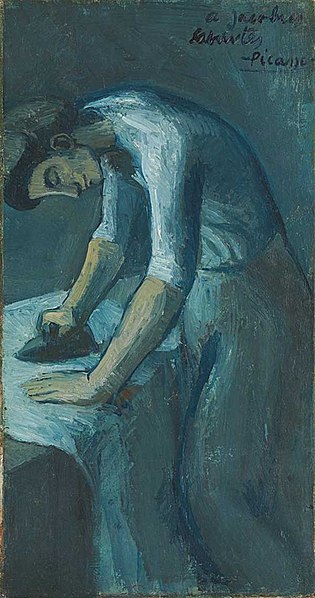
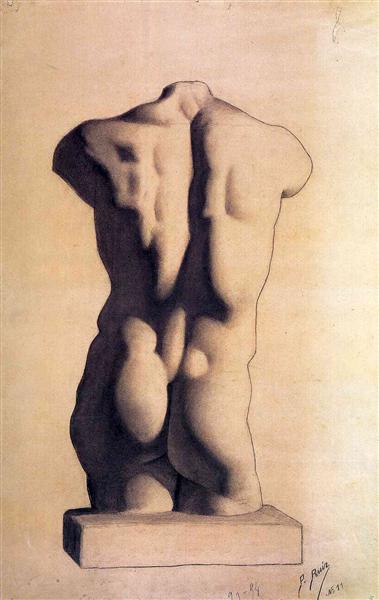
The misery of those years as well as a deep-seated sympathy for the suffering of others shows his understanding of the poor and their condition. Many of his works show the poor in their emaciated and desperately exhausted and exploited conditions. Some historians say that Picasso chose a single color, blue, because he could not afford a variety of paints. It is more likely that he chose it because it imparts a feeling of loneliness and simplicity. Notice in the Woman Ironing that the forms are outlined in heavy lines which are most noticeable at the edges of the fabric she is ironing and the clothes she is wearing. This causes some areas of the canvas to appear flat and even blank. In 1905 Picasso moved back to Paris and spent much of his time at the circus. He often painted circus performers and harlequins and portrays feelings of remoteness and imbalance. During 1905 he also looked at Greek sculpture and vase paintings in the Louvre and incorporated what he saw into his paintings. These classical Greek Kouri were often flat, like the vases on which they were painted. They caused him to begin thinking about space and how it was created on the two dimensional canvas by Renaissance artists. What followed was a revolution of art and the way artists used and depicted space. It was the beginning of Cubism.
So what is cubism? It is the subordination of the figure to the total painting. It could be distorted or cut up into a series of flat-color facets indistinguishable from the planes of the background. The point of view can shift as well. Cubism introduced a new kind of space and a new dimension of time. We can say that cubism, which is not really a good name for it, was partly based on the ideas of Cezanne and Matisse, but the ideas also troubled Picasso and his friend Braque. Braque was unsettled by Picasso’s work Demoiselles d’Avignon and could not get it out of his mind. It is not really Cubism, but it was Picasso’s path to ideas that would later be known as Cubism. These new ideas were modeled after Cezanne’s Bathers and African and Iberian Sculpture. The title, added years later by a friend of the artist, refers to a house of prostitution in Barcelona, on Avignon Street. The staring faces of the central figures and the accentuated masks of the outer figures are disturbingly at variance with the artist’s attempt to integrate the central figures, as angular geometric places, with the geometry of the background. Picasso asserts that even the human figure could be subordinated to the total painting. It could be distorted, cut up, transformed into a series of flat color facets, and become essentially indistinguishable from the environment. The point of view is no longer unified by a single point, but shifts and includes a number of points of view at the same time. It is brilliant originality, but is a vicious treatment of the female body. Watch the Smart history video to learn more about Les Demoiselles d’Avignon.
Les Demoiselles d’Avignon- 1907 5:57
If you receive an error with the link above, use the following link https://smarthistory.org/pablo-picasso-les-demoiselles-davignon/
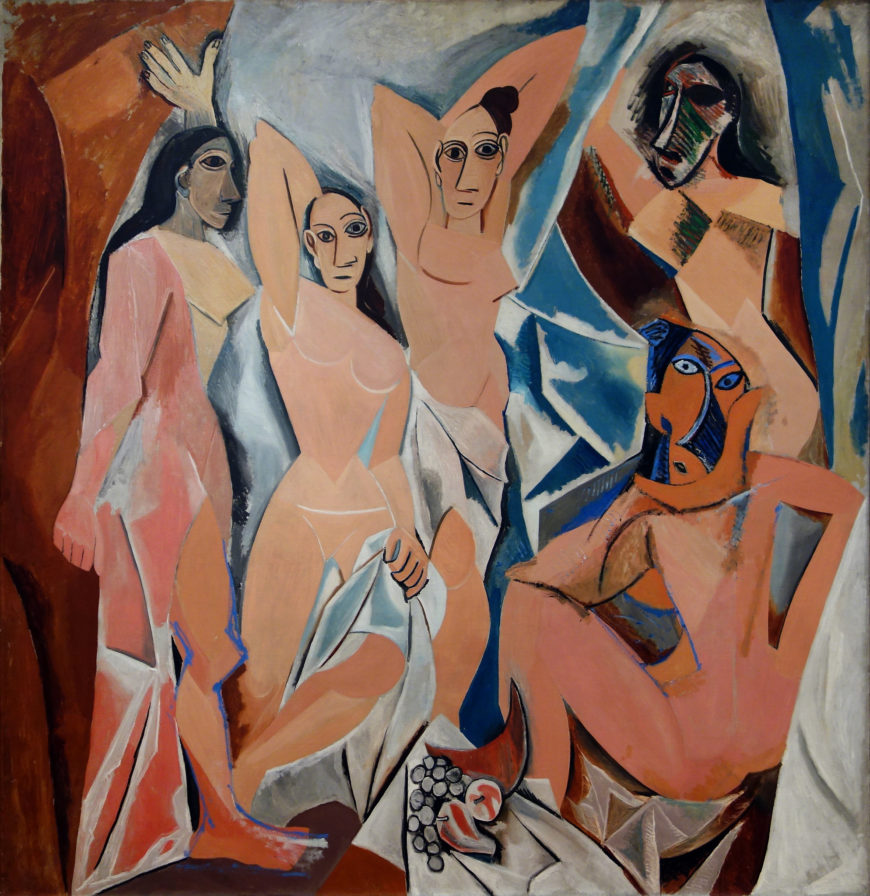
It would be helpful to talk about the three basic types of Cubism and look at an example of each:
Analytical Cubism subordinates color to form, often resulting in a very limited palette-
Watch this video to learn more about analytical Cubism: The Guitarist, Picasso and the new language of Cubism 1910 4:48
If you receive an error with the link above, use the following link https://smarthistory.org/picasso-guitar/
Transitional Cubism continues the use of the Cubist vocabulary but adds real, found objects into the painting. For example, letters. newspapers or rope might be included in the painting in a manner which intrudes on ordinary reality. The use of charcoal pencil often ties the collage together.
Watch this video to learn more about transitional cubism: Still Life with Chair Caning -1912 6:36
If you receive an error with the link above, use the following link https://smarthistory.org/picasso-still-life-with-chair-caning/
Synthetic Cubism is characterized by enrichment of plastic means; space, color, linear movement and texture. Large, intensely colored geometric places interlock and absorb the collage components. There is simplification of faceting.
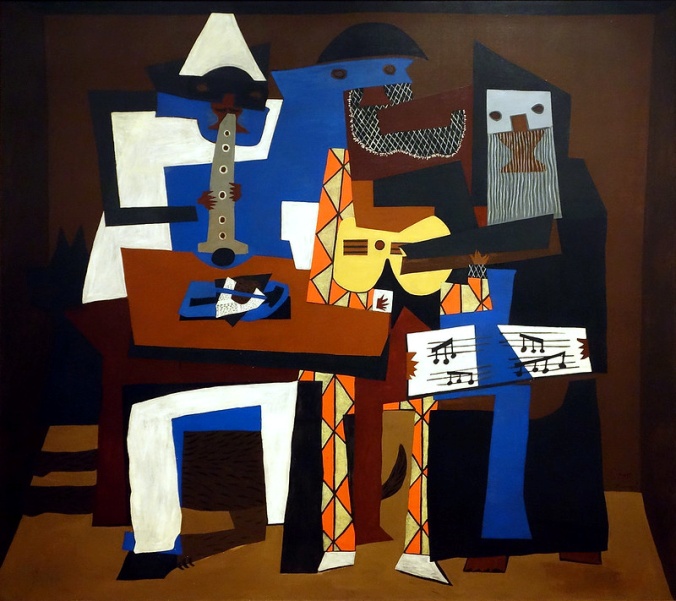
Three Musicians, painted in 1921 was done ten years after the first Cubist paintings were made. It is a good example of Synthetic Cubism. The three figures are seated frontally in a row against a dark background. The colors are flat and brilliant and are still based on geometric forms. Cubism has taken a new step. These are not simply flat-color shapes; they are presences, suggestive perhaps of musicians from an Italian comedy, or of menacing entities pretending to be musicians. They have emerged as definite personalities, perhaps based on Picasso’s youthful fondness for circus characters. The figure on the left playing the clarinet is Pierrot and a harlequin sits in the middle playing a guitar. The figure on the right holds the music and stares outward confronting the viewer.
Picasso’s major painting of the 1930s is Guernica. It was inspired by the Spanish Civil War, specifically the bombing and destruction of the Basque town of Guernica by German bombers in the service of Spanish fascists. Picasso had been active on the side of the loyalists in the Spanish Civil War. In May and June of 1937 he painted this canvas for the Spanish pavilion of the Paris World’s Fair. Numerous studies for the work exist in galleries. The work is still under copyright so we cannot show it fully here, but we are able to use this image of the painting being installed in the Stedlijk Museum in Amsterdam.

Guernica transmits Picasso’s feelings of terror and pity in a generalized sense but is not intended to be a literal telling of the event or the emotions. It is black and white: He did not even need color to express the horror of the moment. The stark colors emphasize the complexity of the interpenetrating places. The outlines are sharp, shade and light are not naturally or recognizably used to create space. This is art is concerned with human affairs and real events, at a time when artists were concentrating on imagination, inner vision, and expression. Picasso used motifs such as a screaming horse, a bellowing bull, a light, a house, and a wounded woman portrayed in unexpected, violent linear distortions to communicate the horror of the event. It is based on cubist ideas, but he has incorporated powerful expressionist ideas that go beyond Cubism. Picasso did not work long in any given style. In fact he seems to have solved the problems of many styles and then moved on to the next new idea. Cubism was one of his most important contributions, but it was only one. The work titled Weeping Woman, painted in brilliant color, was done in 1937, and is contemporary to Guernica. It takes a single woman from the “idea” of the painful Guernica work and gives her a canvas of her own.
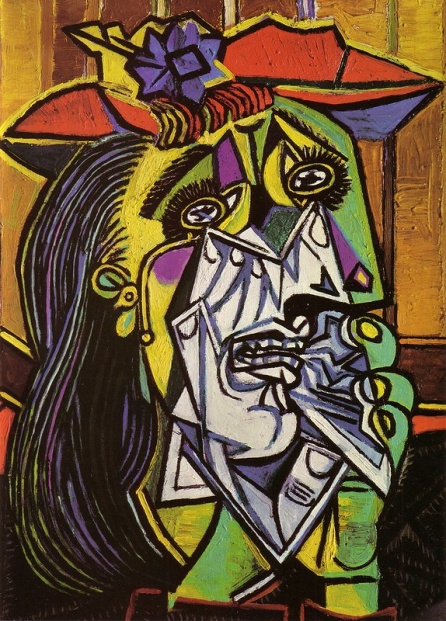
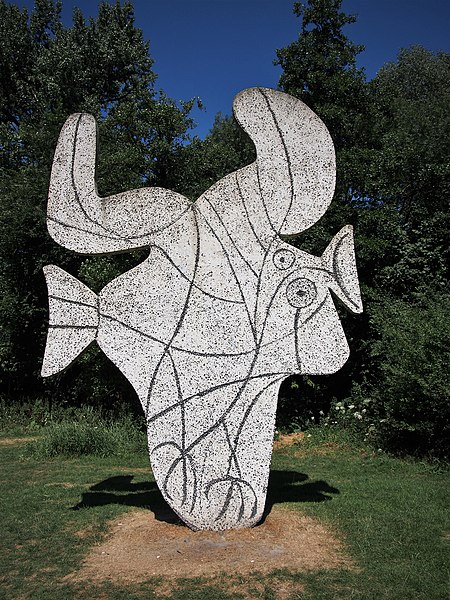
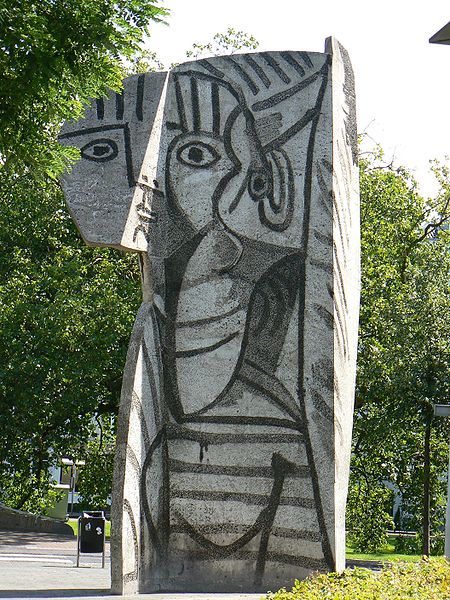
Picasso also worked in sculpture throughout his artistic career. Late in his life he was asked to design works for public spaces which were often completed by other artisans.
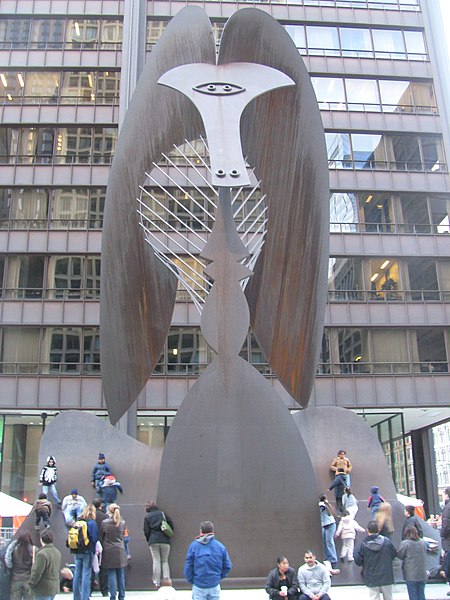
It is difficult to understand the contribution Picasso made to modern art, but it is almost as hard to separate the work of Picasso and his close friend Georges Braque
Georges Braque (1882-1963)
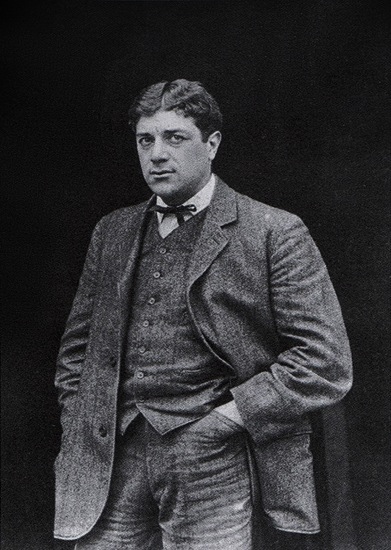
Braque’s father and grandfather were amateur painters and as a boy Georges was encouraged to draw. Following his family trade he was apprenticed as a house painter in 1899 and at the end of 1900 he went to Paris to continue his apprenticeship. After a year in military service and brief academic training, in 1904 he set up his own studio in Paris and began to study the masters in the Louvre. He was eventually influenced by Van Gogh, Seurat, and the Fauves. When he first saw Picasso’s Les Demoiselles d’Avignon he was repelled, but later he began painting similar works. In 1908 when Braque submitted several works to the Salon d’Autumne, the jury refused them referring to “les cubes”. Instead Braque arranged for a one man show. A critic spoke of the artist who reduced everything, landscape and figures and houses, to patterns, to cubes. It was not long before the name cubism was the official name of the movement. During 1908 Picasso and Braque discovered that they were independently converging on the same point, and they decided to work together, which they did until 1914. The still life was their principle subject. Braque’s work depends on his mastery of the two dimensional design, because he maintained that a painting is a flat surface and should remain a flat surface, animated by line, color, and texture. He works within a narrow range of restrained but subtly related colors, often using grays and whites to advantage, with frequent unexpected passages of modulated textures.
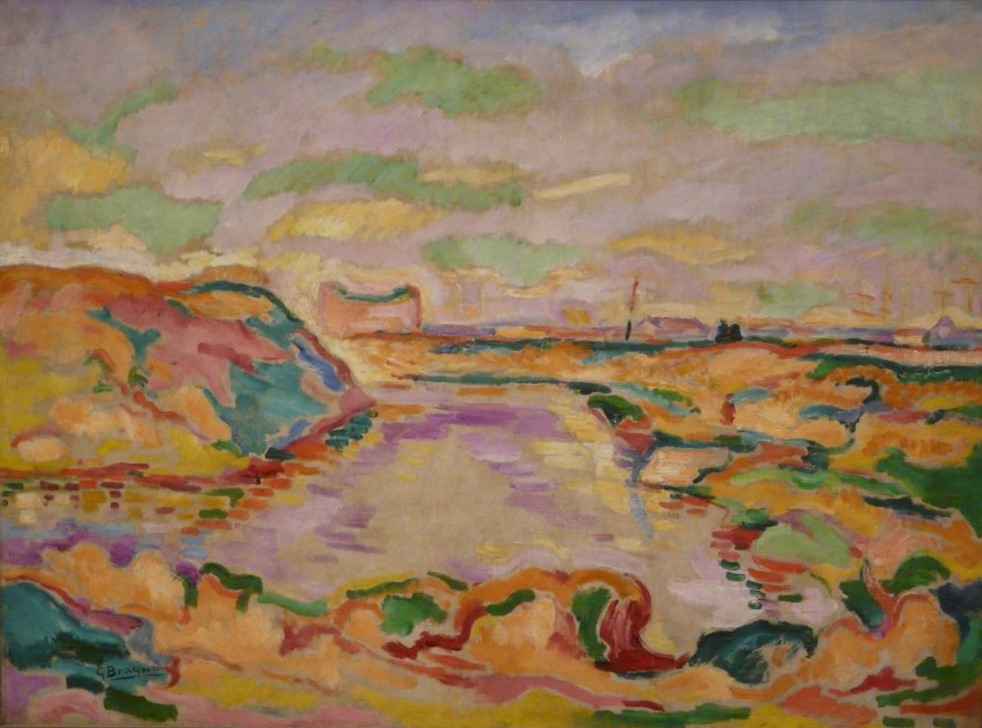
The Landscape near Antwerp was painted during Braque’s Fauvist period and looks much like the works of Matisse. He used bright complementary colors that do not faithfully depict the natural world. The port of Antwerp is similar to Le Havre in Normandy where Braque lived during his childhood and teen years. This work was painted, plein aire, rather than in a studio. This means that he normally would not do preparatory drawings or sketches but took his easel and paints outdoors and worked directly on the canvas, sometimes drawing as he worked.
From 1911 to1914 Braque and Picasso worked along surprisingly similar paths on their way to the development of Cubism. Their styles are so much alike that it is difficult to tell who painted them unless they are signed. It is also hard to determine whether Picasso or Braque first developed Cubism. Some art historians say the first Cubist paintings were based on the work of Cezanne and others look back to primitive African sources of the Picasso. Remember that the first period is often called Analytic Cubism, and that during this time artists dissected their painting into many small facets and then reassembled them into figures or objects. They used mostly monochromatic browns, grays, or blacks to depict still life settings with the human face and figure as well as guitars, pianos, fruit, and glass objects.
In 1915 Braque was serving in the military when he had a serious head injury and spent several months in the hospital. He began painting again in 1917 when Cubism was in its Synthetic phase. Synthetic Cubist works were large pieces of colored paper cut into a shapes and pasted on the canvas. This method flattened space and did not try to create deep space as artists as had tried to do since the Renaissance. Braque’s later work then evolved through different phases of Cubism and his fame and wealth grew.

The Still Life painted by Braque in 1926 uses the basic ideas of Synthetic Cubism, but he does not add found objects and he paints flat shapes to complete forms. The musical instrument to the left cannot be distinguished from its shadow and seems to stand precariously on its end. We are not certain what some of the other objects depict or the viewpoint he is using. He has subordinated the objects to the paint and flattened space so we are left to wonder what we are seeing.

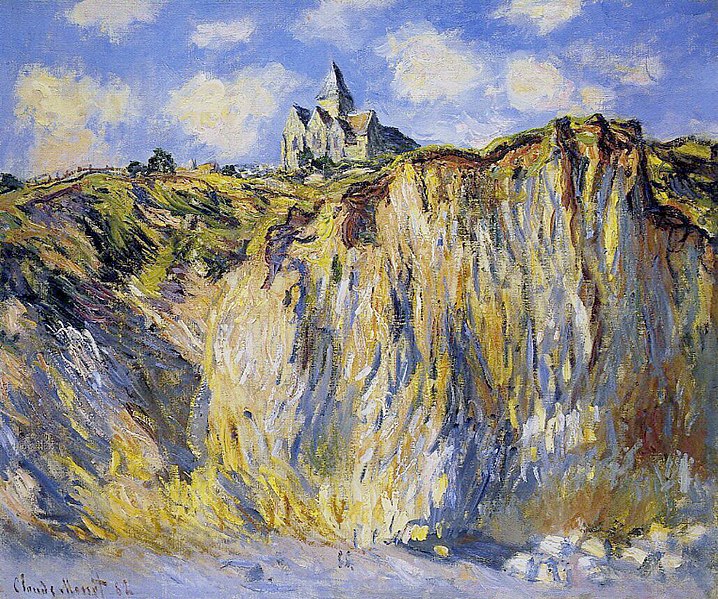
At the end of his life Braque also made etchings, lithographs, engravings, jewelry, sculpture and stained glass. He designed a Tree of Life stained glass window for the isolated church on the cliffs above Varengeville which was painted by many of the Impressionists in their work. The example above is by Claude Monet. Braque was buried in the cemetery at that church on the cliffs of Normandy. His work with the various forms of cubism led artists along a new path, a new way to think of space and color, and it had far-reaching implications for future painters and sculptors.
Juan Gris
Juan Gris (1887-1927) was born Jose Victoriano Gonzalez-Perez in Madrid Spain, although he lived most of his life in France and died in Paris. He was married and had a son, but lived with another woman. His early life was spent drawing illustrations and cartoons for magazines but he began to paint in 1911 and was friends with Georges Braque, Fernand Leger, and Henri Matisse. The Book, painted in 1911, is one of his first experiments in the new cubist style. As we have learned, the purpose of Analytical Cubism is to closely analyze an object without rendering the real appearance, but instead show the different aspects of the appearance as though they can be seen simultaneously. This shows a side view of the teapot and a frontal view at the same time. Individual elements of the objects are arranged on the canvas in a manner which suggests the object, but does not describe any real view of it. The surface of the painting resembles an intricately cut jewel and the individual painted shapes are like facets. The Portrait of Pablo Picasso shows the famous artist holding his palette, but we are not sure of his surroundings and it is only the title of the painting that gives the viewer a hint of who the person is. We see a face from two different views and only part of the hands.
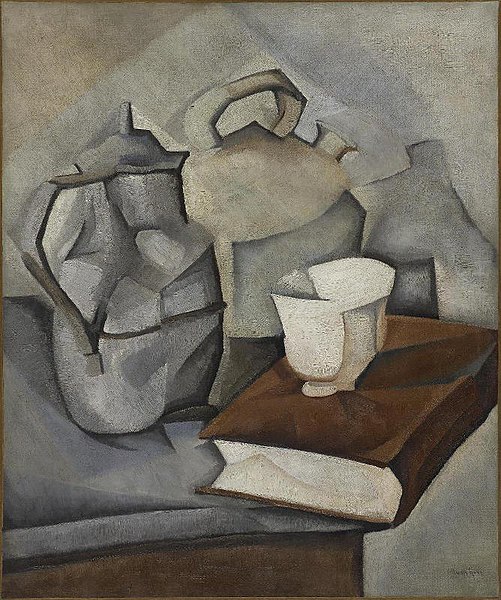
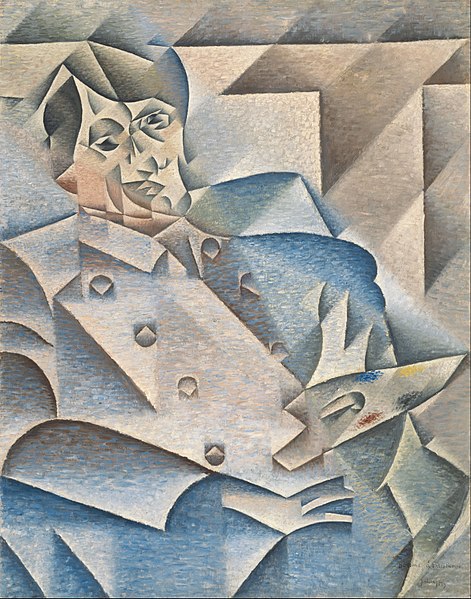
By 1913 Gris began to move on to Synthetic cubism that included pieces of newsprint, musical scores and other paper objects. His synthetic cubist works depict objects broken into pieces but clearly painted. The use of paper flattened space and the dark lines around objects did not allow the eye to move around their edges into the background.
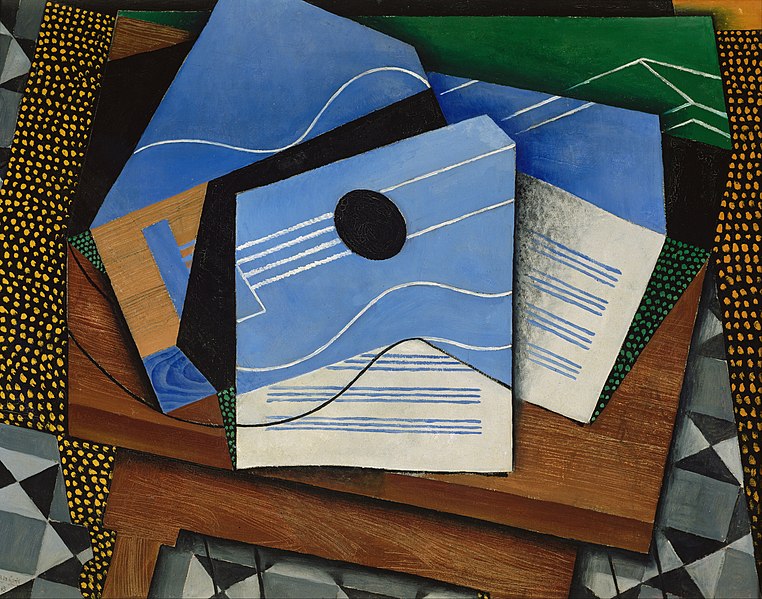
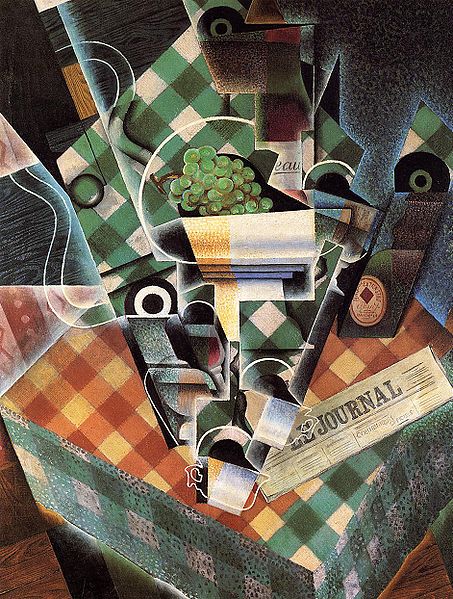
The title of the works tell us the objects which were used to create it, so we know that the instrument on the table is a guitar, but the faceting and shifting of planes has altered the final appearance. The only recognizable images are part of a guitar and some pages of sheet music. Yet the other elements, the wood grain, the decorative pattern at the upper left, are all implied by these two objects. Still Life with Checked Tablecloth is another Synthetic Cubist work. Gris is experimenting with the individual facets or pieces of the objects. Now he alters their location on the canvas so that we see part of the table from the top and part from the side. We see the outline of a guitar, but we can see through it to more of the tablecloth behind it. Perspective is not correct and corners and textures are abstracted from the tablecloth and interspersed throughout the composition. Thus we see the manipulation and its resulting abstraction, which are definitive features of synthetic cubism. Artists began to abandon representation altogether and to pursue the possibilities of fully non-representational painting.

